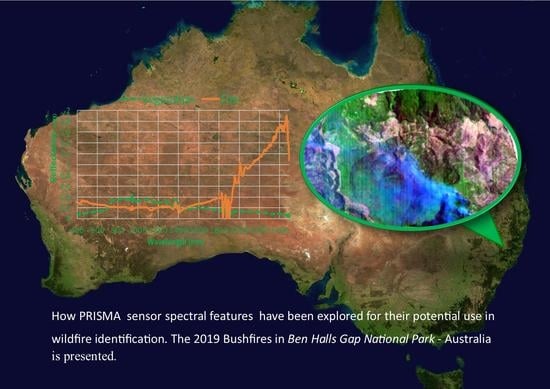Exploring PRISMA Scene for Fire Detection: Case Study of 2019 Bushfires in Ben Halls Gap National Park, NSW, Australia
Abstract
1. Introduction
2. Materials and Methods
2.1. Case Study
2.2. PRISMA Sensor
2.3. PRISMA Scene
2.4. Fire Detection Algorithms
2.4.1. Carbon Dioxide Continuum-Interpolated Band Ratio (CO2-CIBR)
2.4.2. HFDI
2.4.3. Potassium Emission
2.5. Fire Reference for Comparison
3. Results
Fire Detection Analysis
4. Discussion
5. Conclusions
Author Contributions
Funding
Institutional Review Board Statement
Informed Consent Statement
Data Availability Statement
Acknowledgments
Conflicts of Interest
References
- Kaufman, Y.J.; Justice, C.O.; Flynn, L.P.; Kendall, J.D.; Prins, E.M.; Giglio, L.; Ward, D.E.; Menzel, W.P.; Setzer, A.W. Potential global fire monitoring from EOS-MODIS. J. Geophys. Res. Space Phys. 1998, 103, 215–238. [Google Scholar] [CrossRef]
- Dennison, P.E. Fire detection in imaging spectrometer data using atmospheric carbon dioxide absorption. Int. J. Remote Sens. 2006, 27, 3049–3055. [Google Scholar] [CrossRef]
- Flannigan, M.D.; Haar, T.H.V. Forest fire monitoring using NOAA satellite AVHRR. Can. J. For. Res. 1986, 16, 975–982. [Google Scholar] [CrossRef]
- Veraverbeke, S.; Dennison, P.; Gitas, I.; Hulley, G.; Kalashnikova, O.; Katagis, T.; Kuai, L.; Meng, R.; Roberts, D.; Stavros, N. Hyperspectral remote sensing of fire: State-of-the-art and future perspectives. Remote Sens. Environ. 2018, 216, 105–121. [Google Scholar]
- Amici, S.; Wooster, M.J.; Piscini, A. Multi-resolution spectral analysis of wildfire potassium emission signatures using laboratory, airborne and spaceborne remote sensing. Remote Sens. Environ. 2011, 115, 1811–1823. [Google Scholar] [CrossRef]
- Dennison, P.E.; Roberts, D.A. Daytime fire detection using airborne hyperspectral data. Remote Sens. Environ. 2009, 113, 1646–1657. [Google Scholar] [CrossRef]
- Vodacek, A.; Kremens, R.L.; Fordham, A.J.; VanGorden, S.C.; Luisi, D.; Schott, J.R.; Latham, D.J. Remote optical detection of biomass burning using a potassium emission signature. Int. J. Remote Sens. 2002, 23, 2721–2726. [Google Scholar] [CrossRef]
- Dennison, P.E.; Matheson, D.S. Comparison of fire temperature and fractional area modeled from SWIR, MIR, and TIR multispectral and SWIR hyperspectral airborne data. Remote Sens. Environ. 2011, 115, 876–886. [Google Scholar] [CrossRef]
- Matheson, D.S.; Dennison, P.E. Evaluating the effects of spatial resolution on hyperspectral fire detection and temperature retrieval. Remote Sens. Environ. 2012, 124, 780–792. [Google Scholar] [CrossRef]
- Waigl, C.F.; Prakash, A.; Stuefer, M.; Verbyl, D.; Dennison, P. Fire detection and temperature retrieval using EO-1 Hyperion data over selected Alaskan boreal forest fires. Int. J. Appl. Earth Obs. Geoinf. 2019, 81, 72–84. [Google Scholar] [CrossRef]
- Guanter, L.; Kaufmann, H.; Segl, K.; Foerster, S.; Rogass, C.; Chabrillat, S.; Kuester, T.; Hollstein, A.; Rossner, G.; Chlebek, C.; et al. The EnMAP Spaceborne Imaging Spectroscopy Mission for Earth Observation. Remote Sens. 2015, 7, 8830–8857. [Google Scholar] [CrossRef]
- Nieke, J.; Rast, M. Towards the Copernicus Hyperspectral Imaging Mission For The Environment (CHIME). In Proceedings of the IGARSS 2018–2018 IEEE International Geoscience and Remote Sensing Symposium, Valencia, Spain, 22–27 July 2018; pp. 157–159. [Google Scholar] [CrossRef]
- Pitman, A.J.; Narisma, G.T.; McAneney, J. The impact of climate change on the risk of forest and grassland fires in Australia. Clim. Chang. 2007, 84, 383–401. [Google Scholar] [CrossRef]
- Kumar, S.V.; Holmes, T.; Andela, N.; Dharssi, I.; Hain, C.; Peters-Lidard, C.; Mahanama, S.P.; Arsenault, K.R.; Nie, W.; Getirana, A. The 2019–2020 Australian drought and bushfires altered the partitioning of hydrological fluxes. Geophys. Res. Lett. 2021, 48, e2020GL091411. [Google Scholar] [CrossRef]
- Weber, D.; Moskwa, E.; Robinson, G.; Bardsley, D.; Arnold, J.; Davenport, M. Are we ready for bushfire? Perceptions of residents, landowners and fire authorities on Lower Eyre Peninsula, South Australia. Geoforum 2019, 107, 99–112. [Google Scholar] [CrossRef]
- Deb, P.; Moradkhani, H.; Abbaszadeh, P.; Kiem, A.S.; Engström, J.; Keellings, D.; Sharma, A. Causes of the Widespread 2019–2020 Australian Bushfire Season. Earths Futur. 2020, 8. [Google Scholar] [CrossRef]
- Oloruntoba, R. Plans never go according to plan: An empirical analysis of challenges to plans during the 2009 Victoria bushfires. Technol. Forecast. Soc. Chang. 2013, 80, 1674–1702. [Google Scholar] [CrossRef]
- King, A.D.; Pitman, A.J.; Henley, B.J.; Ukkola, A.M.; Brown, J.R. The role of climate variability in Australian drought. Nat. Clim. Chang. 2020, 10, 177–179. [Google Scholar] [CrossRef]
- McArthur, A.G. Fire Behaviour in Eucalypt Forests. Forestry and Timber Bureau, Canberra. 1967. Available online: https://catalogue.nla.gov.au/Record/2275488 (accessed on 3 March 2021).
- Australia in December 2019; Australian Government Bureau of Meteorology. Available online: http://www.bom.gov.au/climate/current/month/aus/archive/201912.summary.shtml (accessed on 30 March 2021).
- Fire and the Environment 2019-20 Summary; Department of Planning, Industry and Environment: Parramatta, Australia, 2020; ISBN 978-1-922318-57-2. Available online: https://www.environment.nsw.gov.au/research-and-publications/publications-search/fire-and-the-environment-2019-20-summary (accessed on 27 October 2020).
- NSW Rural Fire Service. Available online: http://www.rfs.nsw.gov.au/news-and-media/media-releases/dangerous-fire-conditions-extreme-fire-danger (accessed on 27 October 2020).
- PRISMA Catalogue Web. Available online: www.prisma.asi.it (accessed on 1 December 2020).
- Ben Halls Gap National Park Plan of Management. Available online: https://www.environment.nsw.gov.au/-/media/OEH/Corporate-Site/Documents/Parks-reserves-and-protected-areas/Parks-plans-of-management/ben-halls-gap-national-park-plan-of-management-020091.pdf (accessed on 27 October 2020).
- BBC News. Available online: https://ichef.bbci.co.uk/news/320/cpsprodpb/0677/production/_110355610_nsw_vtr_fires_dec31_976-nc.png (accessed on 10 December 2020).
- Smith, R.C. Astrophysical Techniques, Sixth Edition, by C.R. Kitchin. Contemp. Phys. 2014, 55, 359–360. [Google Scholar] [CrossRef]
- Coppo, P.; Brandani, F.; Faraci, M.; Sarti, F.; Cosi, M. Leonardo Spaceborne Infrared Payloads for Earth Observation: SLSTRs for Copernicus Sentinel 3 and PRISMA Hyperspectral Camera for PRISMA Satellite. In Proceedings of the 15th International Workshop on Advanced Infrared Technology and Applications (AITA 2019), Florence, Italy, 17–19 September 2019; Volume 27, p. 1. [Google Scholar] [CrossRef]
- Guarini, R.; Loizzo, R.; Facchinetti, C.; Longo, F.; Ponticelli, B.; Faraci, M.; Dami, M.; Cosi, M.; Amoruso, L.; De Pasquale, V.; et al. PRISMA hyperspectral mission products. In Proceedings of the IGARSS 2018–2018 IEEE International Geoscience and Remote Sensing Symposium, Valencia, Spain, 22–27 July 2018; pp. 179–182. [Google Scholar] [CrossRef]
- Quick Atmospheric Correction (QUAC). Available online: https://www.l3harrisgeospatial.com/docs/quac.html (accessed on 15 December 2020).
- Bernstein, L.S.; Jin, X.; Gregor, B.; Adler-Golden, S.M. The Quick Atmospheric Correction (QUAC) Code: Algorithm Description and Recent Upgrades. SPIE Opt. Eng. 2012, 51, 111719. [Google Scholar] [CrossRef]
- Gao, B.-C.; Goetz, A.F.H. Determination of Total Column Water Vapor in the Atmosphere at High Spatial Resolution from AVIRIS Data Using Spectral Curve Fitting and Band Ratioing Techniques. In Imaging Spectroscopy of the Terrestrial Environment; SPIE: Bellingham, WA, USA, 1990; Volume 1298, pp. 138–149. [Google Scholar]
- Hartley, T.N. Increasing the Potassium Use Efficiency of Crops. Doctoral Dissertation, University of York, York, UK, September 2017. Available online: http://etheses.whiterose.ac.uk/20019/ (accessed on 3 March 2021).
- Clery, D.S.; Mason, P.E.; Rayner, C.M.; Jones, J.M. The effects of an additive on the release of potassium in biomass combustion. Fuel 2018, 214, 647–655. [Google Scholar] [CrossRef]
- Díaz-Ramírez, M.; Frandsen, F.J.; Glarborg, P.; Sebastián, F.; Royo, J. Partitioning of K, Cl, S and P during combustion of poplar and brassica energy crops. Fuel 2014, 134, 209–219. [Google Scholar] [CrossRef]
- McMorrow, J.N.; Coe, H.; McFiggans, G.; Dold, J.; Tantanasi, I.; Gareth, C.; Aylen, J.; Millin-Chalabi, G.; Agnew, C.; Amici, S. Wildfires@Manchester, Poster Royal Society. 2015. Available online: http://www.kfwf.org.uk/_assets/documents/RoySoc_FirePoster_UnivOf_Manchester_McMorrow_etal_5oct15.pdf (accessed on 10 December 2020).
- Hsu, C.-W.; Chang, C.-C.; Lin, C.-J. A Practical Guide to Support Vector Classification. 2010. Available online: http://www.csie.ntu.edu.tw/~cjlin/papers/guide/guide.pdf (accessed on 5 October 2015).
- Foody, G.M.; Mathur, A. A Relative Evaluation of Multiclass Image Classification by Support Vector Machines. IEEE Trans. Geosci. Remote Sens. 2004, 42, 1335–1343. [Google Scholar] [CrossRef]
- Sabat-Tomala, A.; Raczko, E.; Zagajewski, B. Comparison of Support Vector Machine and Random Forest Algorithms for Invasive and Expansive Species Classification Using Airborne Hyperspectral Data. Remote Sens. 2020, 12, 516. [Google Scholar] [CrossRef]
- Ghosh, A.; Fassnacht, F.E.; Joshi, P.K.; Koch, B. A framework for mapping tree species combining hyperspectral and LiDAR data: Role of selected classifiers and sensor across three spatial scales. Int. J. Appl. Earth Obs. Geoinf. 2014, 26, 49–63. [Google Scholar] [CrossRef]
- Xiang, P.; Zhou, H.; Li, H.; Song, S.; Tan, W.; Song, J.; Gu, L. Hyperspectral anomaly detection by local joint subspace process and support vector machine. Int. J. Remote Sens. 2020, 41, 3798–3819. [Google Scholar] [CrossRef]
- Amici, S.; Piscini, A.; Buongiorno, M.; Pieri, D. Geological classification of Volcano Teide by hyperspectral and multispectral satellite data. Int. J. Remote Sens. 2012, 34, 3356–3375. [Google Scholar] [CrossRef]


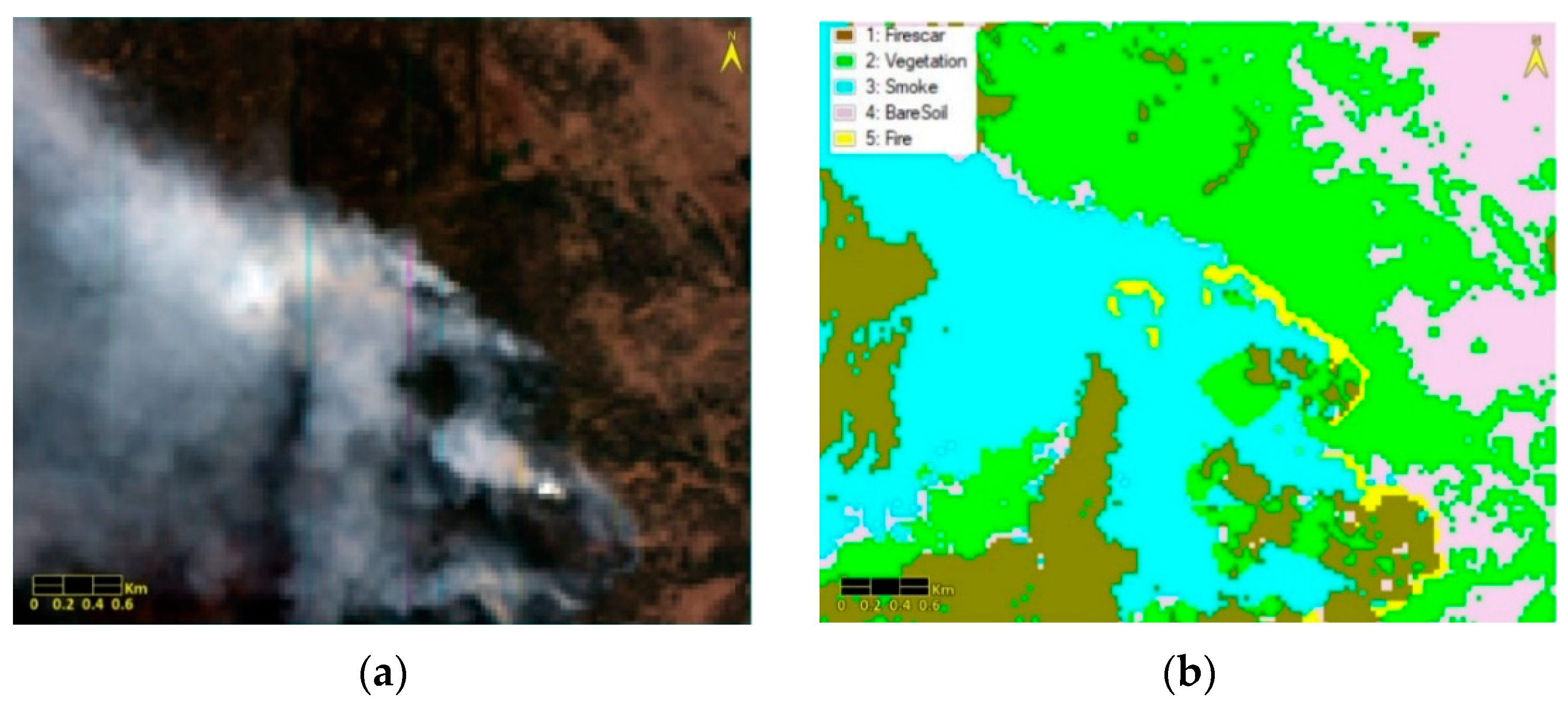
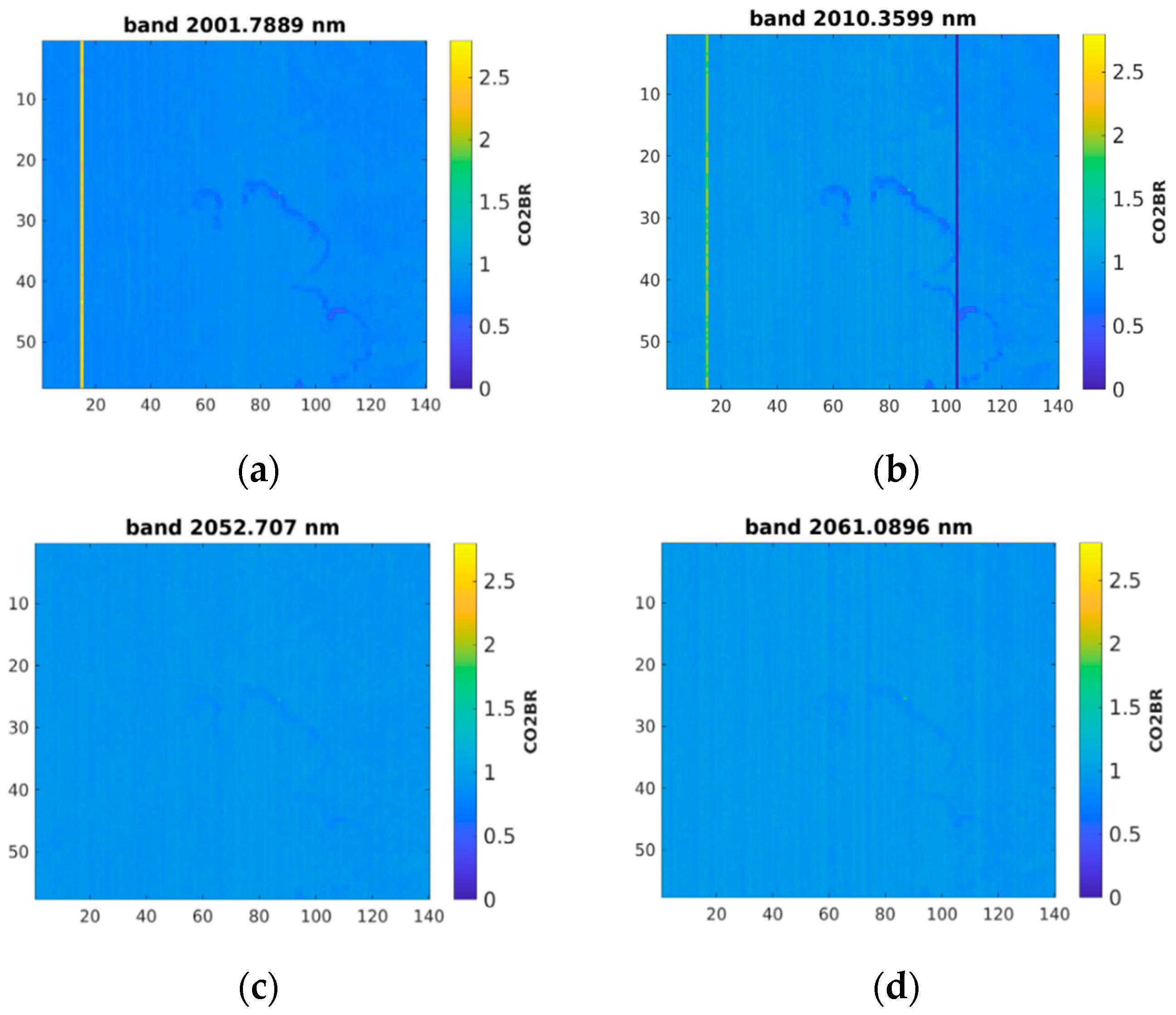
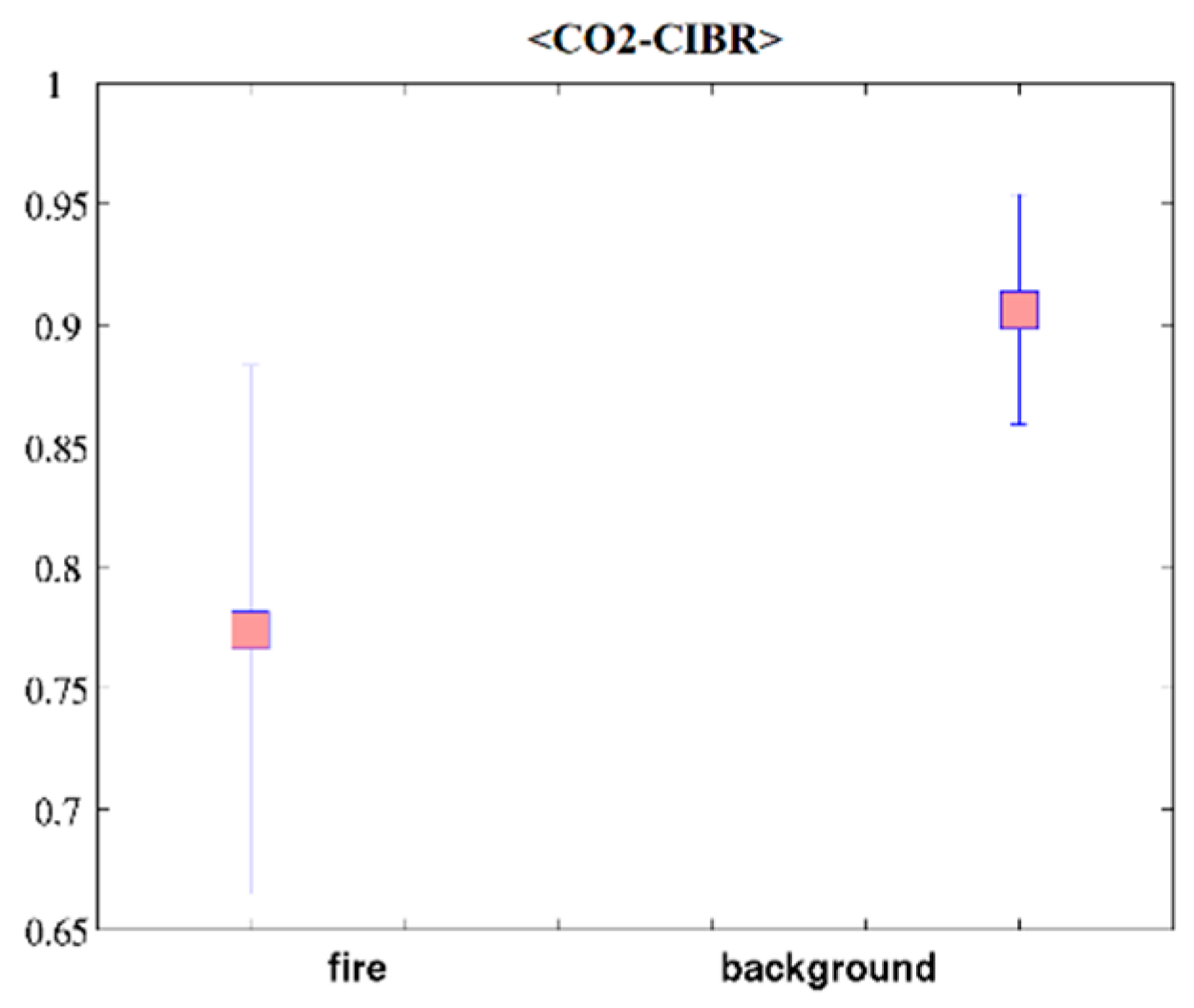
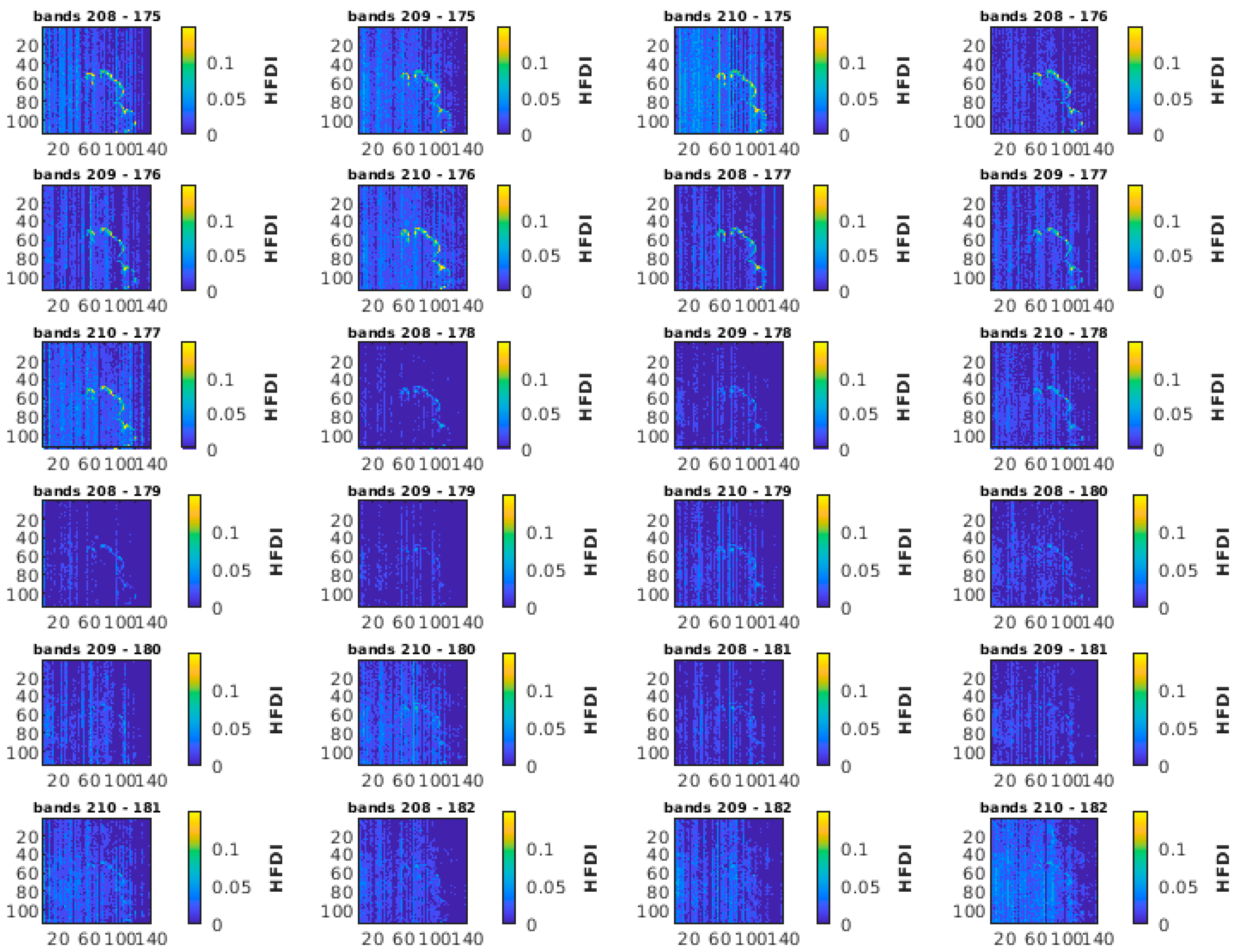
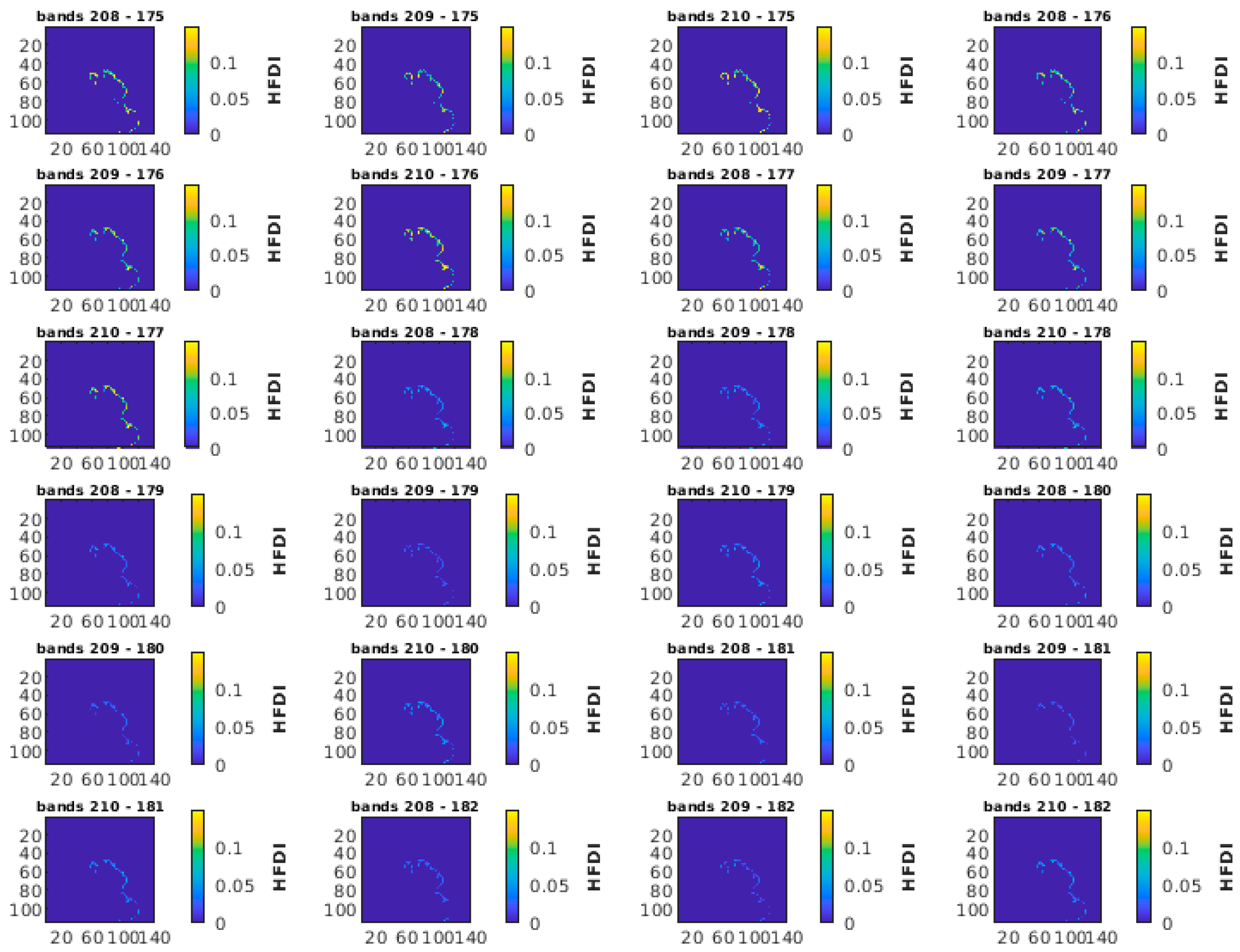
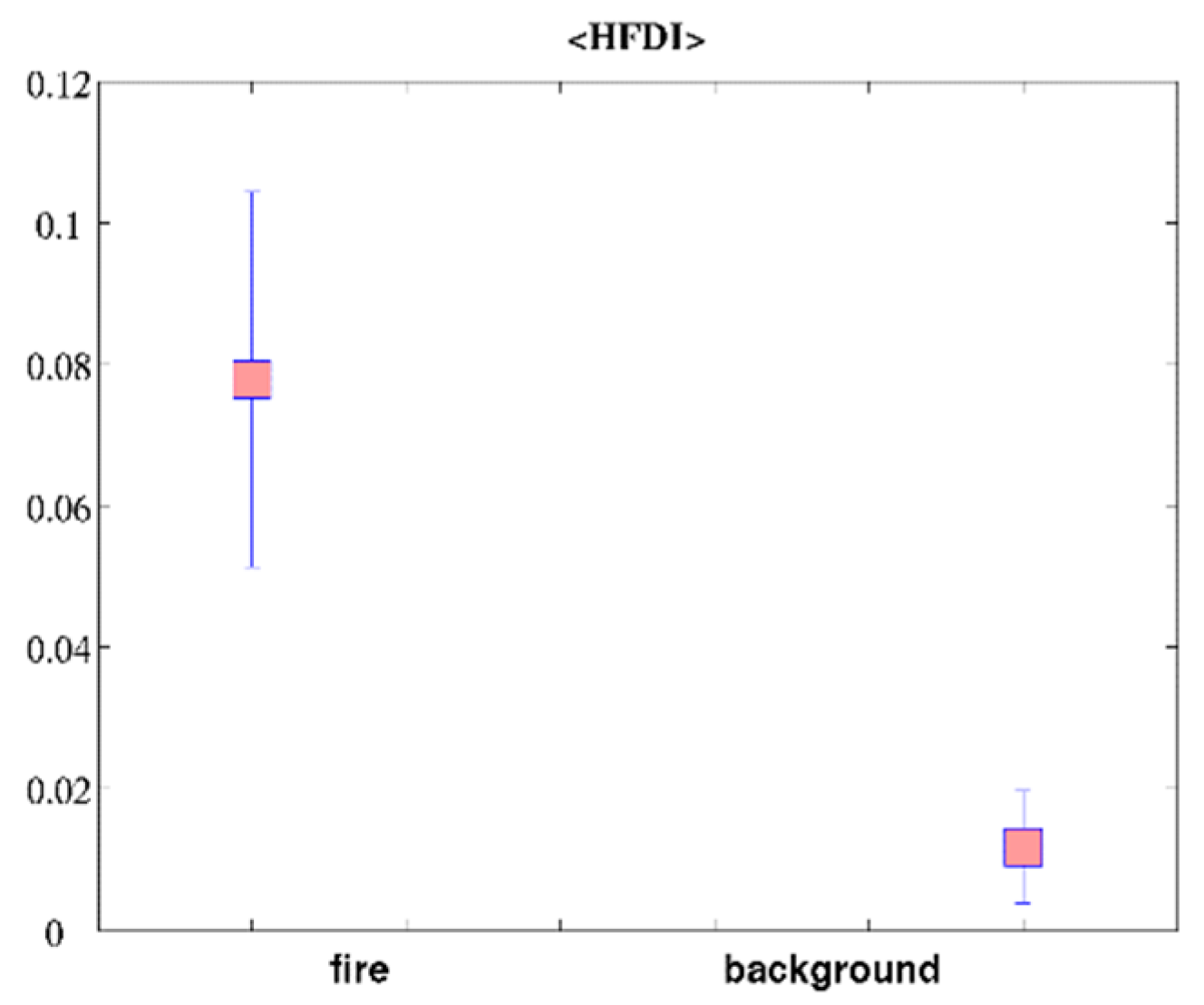

| Description | Value | Unit |
|---|---|---|
| Scene size | 30 × 30 | Km |
| Pixel size nadir | 30 × 30 | M |
| FOV | 2.4 | Degrees |
| Spectral range—VNIR | 400–1010 | Nm |
| Spectral range—SWIR | 920–2505 | Nm |
| Spectral range—PAN | 400–700 | Nm |
| Spectral resolution—VNIR | ≤13 | Nm |
| Spectral resolution—SWIR | ≤14.5 | Nm |
| Spectral resolution—PAN | ≤13.5 | Nm |
| Number of spectral bands—VNIR | 66 | - |
| Number of spectral bands—SWIR | 174 | - |
| Spatial resolution—VNIR-SWIR | 30 | m/px |
| Spatial resolution—PAN | 5 | m/px |
| SNR—VNIR | >160 (>450 at 650 nm) | - |
| SNR—SWIR | >100 (>360 at 1550 nm) | - |
| SNR—PAN | >240 | - |
| Absolute radiometric accuracy | Better than 5% | - |
| λm | λ2 | λ3 | W2 | W3 |
|---|---|---|---|---|
| 2001.79 | 1984.49 | 2035.94 | 0.6640 | 0.3360 |
| 2010.36 | 1984.49 | 2035.94 | 0.4972 | 0.5028 |
| 2052.70 | 2035.94 | 2086.04 | 0.66538 | 0.33462 |
| 2061.09 | 2035.94 | 2086.04 | 0.49807 | 0.50193 |
| Band 1 | Band 2 | Band 3 | λm (nm) | λ2 (nm) | λ3 (nm) | Cut-off Min | Cut-off Max | Detection Rate |
|---|---|---|---|---|---|---|---|---|
| 169 | 167 | 173 | 2001.79 | 1984.49 | 2035.94 | 0.55094 | 0.74674 | 0.81598 |
| 179 | 167 | 173 | 2010.36 | 1984.49 | 2035.94 | 0.32421 | 0.85531 | 0.29205 |
| 175 | 173 | 179 | 2052.71 | 2035.94 | 2086.04 | 0.78086 | 0.89774 | 0.25083 |
| 176 | 173 | 179 | 2061.09 | 2035.94 | 2086.04 | 0.75938 | 0.93708 | 0.13561 |
| Band 1 | Band 2 | Central λ1 (nm) | Central λ2 (nm) | Cut-Off Min | Cut-Off Max | Detection Rate |
|---|---|---|---|---|---|---|
| 208 | 175 | 2312.80 | 2052.70 | 0.08 | 0.19192 | 0.8223 |
| 209 | 175 | 2320.58 | 2052.71 | 0.08 | 0.19111 | 0.75852 |
| 210 | 175 | 2327.54 | 2052.72 | 0.08 | 0.21888 | 0.83235 |
| 208 | 176 | 2312.85 | 2061.08 | 0.05 | 0.17544 | 0.88431 |
| 209 | 176 | 2320.59 | 2061.09 | 0.08 | 0.17544 | 0.67228 |
| 210 | 176 | 2327.55 | 2061.10 | 0.08 | 0.20339 | 0.84063 |
| 208 | 177 | 2312.86 | 2069.49 | 0.05 | 0.16256 | 0.79732 |
| 209 | 177 | 2320.60 | 2069.50 | 0.05 | 0.15021 | 0.83295 |
| 210 | 177 | 2327.56 | 2069.51 | 0.08 | 0.17842 | 0.76144 |
| 208 | 178 | 2312.87 | 2077.70 | 0.05 | 0.092593 | 0.50731 |
| 209 | 178 | 2320.61 | 2077.71 | 0.05 | 0.080645 | 0.36171 |
| 210 | 178 | 2327.57 | 2077.72 | 0.05 | 0.10938 | 0.64754 |
| 208 | 179 | 2312.88 | 2086.04 | 0.05 | 0.075472 | NaN 1 |
| 209 | 179 | 2320.62 | 2086.05 | 0.05 | 0.059289 | NaN |
| 210 | 179 | 2327.58 | 2086.06 | 0.05 | 0.088123 | NaN |
| 208 | 180 | 2312.89 | 2094.36 | 0.05 | 0.066667 | NaN |
| 209 | 180 | 2320.63 | 2094.37 | 0.05 | 0.058824 | NaN |
| 210 | 180 | 2327.59 | 2094.38 | 0.05 | 0.083969 | NaN |
| 208 | 181 | 2312.90 | 2102.49 | 0.05 | 0.065421 | NaN |
| 209 | 181 | 2320.64 | 2102.50 | 0.05 | 0.050000 | NaN |
| 210 | 181 | 2320.59 | 2102.51 | 0.05 | 0.073684 | NaN |
| 208 | 182 | 2327.55 | 2110.77 | 0.05 | 0.064516 | NaN |
| 209 | 182 | 2312.86 | 2110.78 | 0.05 | 0.058824 | NaN |
| 210 | 182 | 2320.60 | 2110.79 | 0.05 | 0.076923 | NaN |
Publisher’s Note: MDPI stays neutral with regard to jurisdictional claims in published maps and institutional affiliations. |
© 2021 by the authors. Licensee MDPI, Basel, Switzerland. This article is an open access article distributed under the terms and conditions of the Creative Commons Attribution (CC BY) license (https://creativecommons.org/licenses/by/4.0/).
Share and Cite
Amici, S.; Piscini, A. Exploring PRISMA Scene for Fire Detection: Case Study of 2019 Bushfires in Ben Halls Gap National Park, NSW, Australia. Remote Sens. 2021, 13, 1410. https://doi.org/10.3390/rs13081410
Amici S, Piscini A. Exploring PRISMA Scene for Fire Detection: Case Study of 2019 Bushfires in Ben Halls Gap National Park, NSW, Australia. Remote Sensing. 2021; 13(8):1410. https://doi.org/10.3390/rs13081410
Chicago/Turabian StyleAmici, Stefania, and Alessandro Piscini. 2021. "Exploring PRISMA Scene for Fire Detection: Case Study of 2019 Bushfires in Ben Halls Gap National Park, NSW, Australia" Remote Sensing 13, no. 8: 1410. https://doi.org/10.3390/rs13081410
APA StyleAmici, S., & Piscini, A. (2021). Exploring PRISMA Scene for Fire Detection: Case Study of 2019 Bushfires in Ben Halls Gap National Park, NSW, Australia. Remote Sensing, 13(8), 1410. https://doi.org/10.3390/rs13081410






